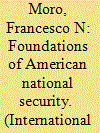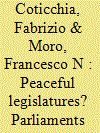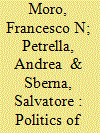| Srl | Item |
| 1 |
ID:
084667


|
|
|
| 2 |
ID:
176024


|
|
|
|
|
| Summary/Abstract |
The article contributes to the growing debate on parliamentary war powers and shows how parliaments matter in shaping both force deployment and force employment. Through original analysis of the Italian and German decision-making on military interventions after the Cold War, the article illustrates how formal and informal constraints shape the opportunity structures faced by executives that are willing to undertake military interventions. Revisiting, and building on, the great deal of research recently emerged on institutional constraints to the use of force, the article details the types of costs – namely, transaction and audience costs – linked to involvement of legislatives in the decision-making and provides empirical support for theories based on parliamentary war powers, adding new dimensions of analysis.
|
|
|
|
|
|
|
|
|
|
|
|
|
|
|
|
| 3 |
ID:
144930


|
|
|
|
|
| Summary/Abstract |
Violence perpetrated by organized crime nowadays represents a major threat to state stability, both because it directly challenges political institutions, targeting officials and using terrorist techniques, and because severe inter-group conflict strongly affects human security. Though it is a distinctive feature of illegal markets and a constant strategy of Mafia-like groups, the occurrence of violence is localized in time and space. The article aims to explain temporal and spatial variation in Mafia killings focusing on its political determinants, as organized crime is deeply embedded in the political system. The analysis shows that there is a clear link between the structure of the political markets and the severity of violence. In particular, the fragmentation of the political market is negatively associated with the strategy of criminal groups to exploit violence. By contrast, single-party dominance and bipartisanship lead to an increase in homicides since these organizations have few opportunities to access the political arena. Outcomes are assessed through the analysis of monthly homicides reported by police forces in Italian provinces from 1983 to 2008.
|
|
|
|
|
|
|
|
|
|
|
|
|
|
|
|
| 4 |
ID:
160790


|
|
|
|
|
| Summary/Abstract |
Violence is a key means used by organized crime to assert its control over territory and business. A widespread view is that violence is bound to take place also in the new territories where mafia groups migrate. In this article, we maintain that this view overlooks two important factors. First, criminal organizations acting in nontraditional areas face a structure of constraints and opportunities that do not generally favor the adoption of violence as a successful organizational strategy. Second, we show that violence, when it takes place, results from the transfer of conflicts that have their roots in the territories of origin of criminal groups. Local conditions play a mediating role in shaping violence in the new territories. We provide empirical support for these statements through the quantitative analysis of the violence perpetrated by mafia groups in Italy in the period between 1983 and 2013.
|
|
|
|
|
|
|
|
|
|
|
|
|
|
|
|